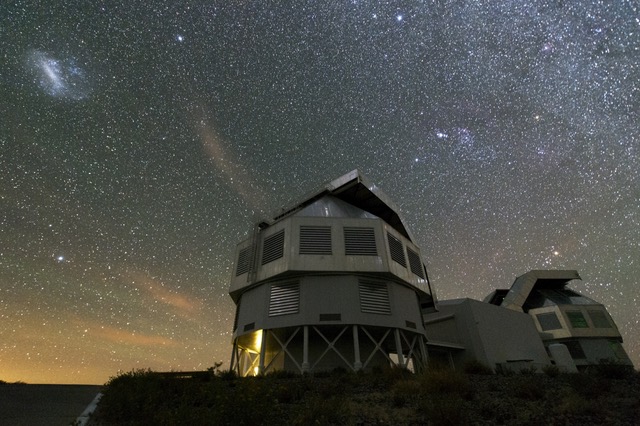
The Magellan 6.5-meter telescopes at Las Campanas Observatory in northern Chile is where much of the data used in this study were obtained. At upper left is the Large Magellanic Cloud, the galaxy in which the stars are located. Credit: Kathryn Neugent.
Flagstaff, AZ. – An international team of scientists has determined that massive stars do not make as much oxygen as previously thought. The finding is highly unexpected and has implications not only for stellar evolution but also for explaining how heavy black holes form. The study has just been accepted for publication in the Astrophysical Journal and may be accessed at https://arxiv.org/abs/2204.04258.
The team, led by Northern Arizona University graduate student and Lowell Observatory Researcher Erin Aadland, studied the physical properties of Wolf-Rayet stars in the nearby galaxy known as the Large Magellanic Cloud, located about 165,000 light-years away. Wolf-Rayets are massive stars (with more than 30 times the mass of our Sun) in the last stages of their lives, shortly before they explode as supernovae.
Results of the four-year research project showed that these Wolf-Rayet stars contain more carbon—and less oxygen—than any models of stellar evolution predict. The only way the team can explain this: the nuclear reaction that converts carbon and helium into oxygen is not running as fast as theorists had calculated.
Massive stars in this late stage of their lives have exhausted their supply of hydrogen fuel and are burning helium as their energy source. There are two nuclear reactions involved, the first of which fuses helium in order to produce carbon. As the amount of carbon increases, a second reaction sets in, combining carbon with helium in order to produce oxygen. These nuclear reactions are how most of the carbon and oxygen in the universe are produced.
“It is this second reaction that we found is less active than theorists have assumed. If so, this helps solve a problem that has been around for several years,” Aadland explained. In 2015, scientists detected the first gravitational waves, which are ripples in space. This opened a new era of astronomy, providing a means of measuring the masses of black holes that are spiraling into one another. As these black holes merge, they generate intense gravitational waves. A few of the gravitational wave detections can best be explained by the merger of black holes with masses in the range of 50 to 85 times the mass of the Sun. However, such black holes shouldn’t exist based on a theoretical prediction: stars which end their lives with masses of 50-120 times that of the Sun should completely blow themselves apart rather than leave behind black holes.
Several recent studies, however, have suggested that if only the rate of producing oxygen was a lot lower than scientists have assumed, the problem would go away, and such black holes should exist. “These suggestions have been ad hoc, in the sense that there has been no hard evidence to support a problem with the reaction rate, until now,” said team member Phil Massey of Lowell Observatory.
To obtain their result, Aadland and her colleagues analyzed spectra that were taken in the ultraviolet by the Hubble Space Telescope, and in the optical and near-infrared using the 6.5-meter Magellan telescopes located on Las Campanas in northern Chile. In order to determine the properties of these stars, the team used sophisticated computer programs to produce models of their light intensity (spectra). They then compared these to the observed spectra and adjusted the input parameters until there was a good match.
The team also included John Hillier (University of Pittsburgh), Kathryn Neugent (University of Toronto and Lowell Observatory), Nidia Morrell (Carnegie Observatory), and Jan Eldridge (University of Auckland). The work was supported by the National Science Foundation and NASA and constitutes Aadland’s PhD thesis at Northern Arizona University, which she successfully defended last week.
###
About Lowell Observatory
Lowell Observatory is a private, nonprofit 501(c)(3) research institution, founded in 1894 by Percival Lowell atop Mars Hill in Flagstaff, Arizona. The Observatory has been the site of many important discoveries, including the first detection of large recessional velocities (redshift) of galaxies by Vesto Slipher in 1912-1914 (a result that led ultimately to the realization that the universe is expanding), and the discovery of Pluto by Clyde Tombaugh in 1930. Today, the Observatory’s 14 tenured astronomers use ground-based telescopes around the world, telescopes in space, and NASA planetary spacecraft to conduct research in diverse areas of astronomy and planetary science. Lowell Observatory currently operates multiple research instruments at its Anderson Mesa station, east of Flagstaff, and the 4.3-meter Lowell Discovery Telescope near Happy Jack, Arizona. Prior to the pandemic, the observatory also welcomed more than 100,000 guests per year to its Mars Hill campus in Flagstaff, Arizona, for a variety of educational experiences, including historical tours, science presentations, and telescope viewing.
###
Media Contact
Kevin Schindler, Lowell Observatory PIO
(928) 607-1387